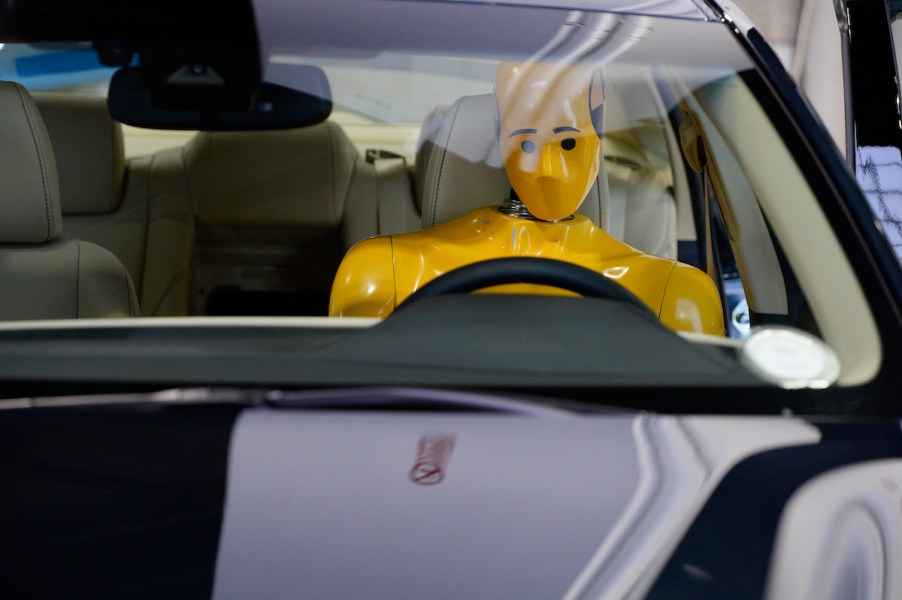
NHTSA’s Proposed Car Safety Updates Ignore Women, Critics Say
Car safety is one of the most important aspects to consider when buying a vehicle. Motorists often face dangerous road conditions, like rain, construction, and distracted drivers. The National Highway Traffic Safety Administration recently announced that it’s exploring strategies to update its 5-Star Safety Ratings System to ensure safety for U.S. road users. But critics argue the NHTSA‘s proposed safety updates ignore women.
What is the NHTSA 5-Star Safety Ratings system?

The U.S. Highway Safety Act developed the NHTSA and outlined its main goal: to minimize traffic deaths, injuries, and economic losses leading to car crashes. Eight years later, the government agency began testing and racing cars for frontal-impact protection based on data from crash test dummies.
In 1993, the NHTSA began using the 5-Star Safety Ratings system to assist car buyers in making informed choices. The program assesses how cars perform in crash tests. The NHTSA carries out frontal, side, and rollover tests because they account for most crashes on U.S. roads.
In 2004, the agency launched SaferCar.gov, currently known as NHTSA.gov, to enable car buyers to search for vehicles with 5-Star Safety Ratings and find other vital highway safety details on one platform. But that didn’t mark the end of changes in the program. In 2006, the organization incorporated window labels for cars with 5-Star Safety Ratings.
The last update came in 2016 when the NHTSA included automatic emergency braking systems on the list of recommended technologies to minimize the effects of speed in rear-end crashes. All new cars are expected to comply with these standards.
However, the NHTSA continues to evolve its safety standards. It has proposed new updates to the 5-Star Safety Ratings system. But the plans face criticism for excluding women from safety testing.
The proposed changes to the NHTSA’s 5-Star Safety Ratings ignore women, critics say
The plan to change the 5-Star Safety Ratings, also called the New Car Assessment Program (NCAP), aims to enhance protection for drivers. According to The Drive, the safety adjustments include new cars being equipped with four new driver assistance technologies: pedestrian automatic emergency braking, blind-spot intervention, lane-keeping assist, and blind-spot detection.
The hope is that driver assistance technologies can halt crashes before they occur rather than reduce impact during car accidents. The changes will also entail a more careful assessment process and criteria for driver assistance technologies.
But that won’t be the end of changes to the 5-Star Safety Ratings program. The NHTSA intends to develop a 10-year roadmap for NCAP updates. There will also be a discussion on incorporating other new technologies into the program recommendation system. These changes intend to improve driver monitoring systems and measure driver intoxication.
Prominent individuals such as Transportation Secretary Pete Buttigieg stand behind the changes, noting they will minimize collisions by ensuring car buyers have information about the updated safety technologies required for new cars.
However, former U.S. Rep. Susan Molinari has criticized the proposed changes for failing to address the existing gender gap in car safety assessment, Axios reports.
“Until we require up-to-date female dummies in all crash tests, as the rule proposes to do for men, the U.S. government is sending a signal that it doesn’t believe women’s lives are as important as men’s,” Molinari stated.
Car crashes are deadlier for women than for men
It takes only a second for a vehicle to cross the center line on a highway and collide with another car. The outcome depends on speed, the type of vehicle, and road conditions. But it can also depend on the person behind the wheel.
An Insurance Institute for Highway Safety (IIHS) study and University of Virginia research show that female drivers are at about a 70% higher risk of sustaining severe injuries than male drivers in similar crashes. Female drivers are also about 20% likelier to be involved in fatalities.
Despite the data, most car safety tests use male crash test dummies. “But designing safety systems to protect the ‘average male’ leaves everyone else more vulnerable,” Axios reports. “In the race to develop self-driving cars, some safety advocates worry the danger women face in today’s vehicles could be pushed aside to focus on AV safety.”
Critics assert that the NHTSA’s 5-Star Safety Ratings program has ignored female drivers for decades. Although the proposed changes to the program are good, the agency needs to go further by addressing the gender gap.


